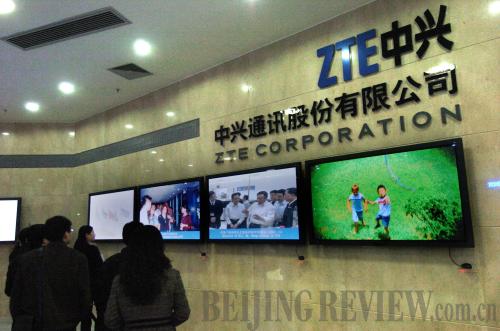|
 |
|
BETTER AND SMARTER: ZTE Corp., China's second largest telecommunications equipment and phone maker, aims to sell more smartphones to developed markets (XINHUA) |
The goal of ZTE Corp., the second largest telecommunications equipment and phone maker in China, has remained simple and unchanged for the past four years, continuing to push further into the European and American markets.
At the four-day Mobile World Congress (MWC), the world's largest mobile technology fair, in 2006, the Chinese telecom giant proudly displayed its slogan "Making the World Converge," a symbol of its commitment to global telecommunications.
While the company has altered its strategy since 2006, it has always kept its overall goal in mind. At this year's MWC, the company focused on its variety of wireless terminal products, including handsets and data cards, rather than its system solutions.
The move is one of ZTE's overseas strategies to burnish its brand by introducing more low-cost quality cell phones and data cards to overseas customers. The company ranked No. 4 in the world in terms of handset unit sales in the last quarter of 2009 and sells cell phones to more than 160 countries.
"Sales of ZTE terminal products grew by more than 40 percent year on year in 2009 and we hope to keep growth around that figure this year too," He Shiyou, Executive Vice President of ZTE, said at the fair. "Sales of wireless terminals surpassed 60 million last year. This year we expect to sell 80 million."
While expecting healthy demand for its wireless handsets and data cards to continue, the company also anticipates subscribers for its handsets based on homegrown TD-SCDMA technology to increase by 500 percent this year.
Wide platform coverage
Predictions indicate that subscribers for mobile broadband connections would reach more than 3 billion in five years from the current 300 million worldwide creating a surge in demand for smartphones. Domestic handset makers such as ZTE and Huawei Corp. are gearing up to turn this growth into a profit boost.
The number of mobile broadband connection users will witness "an explosive growth" when the average selling price of smartphones decreases to below $150 from above $300 in a couple of years, according to Xu Xinquan, vice president of Huawei's terminal subsidiary.
"Everyone has to get ready for the turning point, be it Internet content providers or handset makers," He told NetEase's tech channel during the MWC.
ZTE debuted its ZTE Bingo, which they dubbed "the world's first ultra-slim big-screen BMP 3G smartphone," at the fair this year, in addition to five smartphone models based on Google's open-source operating system, Android.
BMP refers to the Brew Mobile Platform developed by U.S. wireless telecommunications giant Qualcomm. This, plus models based on Linux, Windows Mobile and OMS-platform phones already available on the company's product portfolio, made ZTE one of the few handset makers to offer smartphones for a variety of mobile operating systems.
ZTE is also a member of the Symbian Foundation, a non-profit organization that manages the open-source Symbian platform, the successor to Symbian OS—the world's No.1 operating system for smartphones used in Apple Inc.'s iPhone.
"We don't have a large number of Symbian-based models, because the majority of our clients don't have this requirement. But with a relevant technological repertoire, we are able to produce Symbian-based handsets if they want one," said Xiong Hui, ZTE's Vice President for handset marketing.
Tailor-made handsets
ZTE produces handsets largely for contracts from telecom operators. According to Xiong, the fact ZTE develops handsets according to operators' contracts is conducive to ensuring the healthiness of its business.
"We need the right timing to promote services and software for 3G handsets, especially smartphones, and we haven't launched the five Android models until operators inked contracts for them. That's the way we develop handsets," Xiong said, adding that this mode of ZTE's handset development is unlikely to change in the next few years.
On the European market, operators including Vodafone, Orange, Telefonica and T-Mobile have all begun to purchase tailor-made handsets and data cards from ZTE.
A Goldman Sachs report says smartphone sales will grow by 38 percent in 2010. Earlier this year, ZTE established a European office for mobile phone operations to better tailor products for European customers and ensure a stronger market and brand presence.
"Smartphones will become a very important development direction for ZTE in 2010 in Europe and even worldwide," said Lin Qiang, president of ZTE's European office for mobile phone operations.
| 